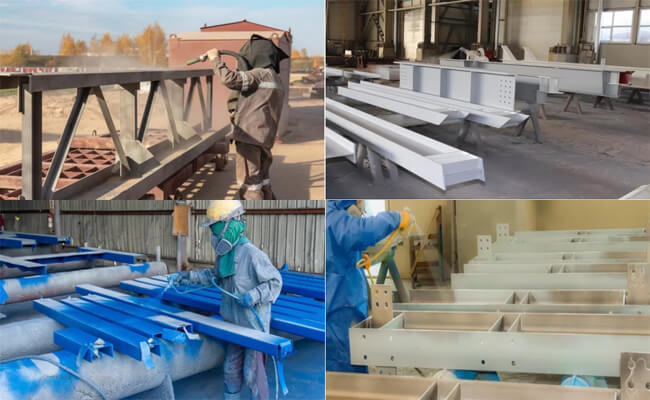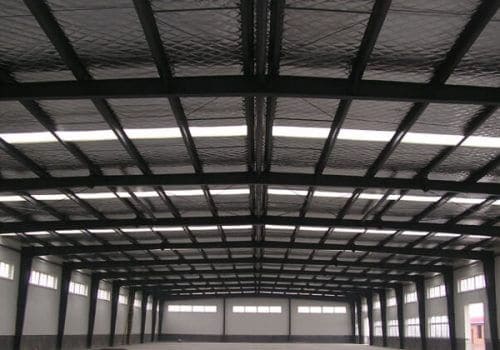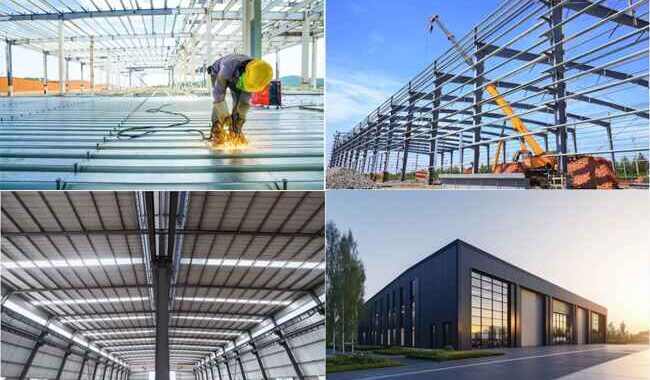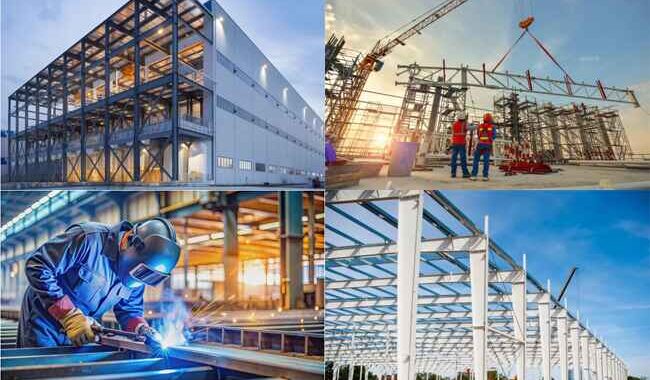What steel structure knowledge do you need to know to build a steel building project? Steel structures are widely used…
The steel structure painting process is a commonly used surface treatment method, which can provide a protective coating and extend the service life of the steel structure.
The painting process can effectively prevent the steel structure from being oxidized, corrupted, and worn and beautify its appearance.

Steel structure painting process
Before painting the steel structure, you need to do the preparation work first. This includes determining the color and type of the paint, checking the use of the painting equipment and tools, and preparing the required paint and auxiliary materials.
The steel structure painting process usually includes the following steps: preparation, surface treatment, primer coating, intermediate coating, topcoat coating, and coating detection.
Preparation
Before painting the steel structure, you need to do the preparation work first. This includes determining the color and type of the paint, checking the use of the painting equipment and tools, and preparing the required paint and auxiliary materials.
1. Material
1) The selection of anti-corrosion materials for steel structure projects should meet the design requirements. Anti-corrosion materials include primers, topcoats, and thinners. Anti-corrosion primers for building steel structure projects include red lead oily anti-rust paint, molybdenum chromium red epoxy ester anti-rust paint, etc.; anti-corrosion topcoats for building steel structures include various alkyd enamels and various alkyd blended paints. Various anti-corrosion materials should meet relevant national technical indicators’ requirements and have product factory certificates.
2. Main machines and tools:
Sandblasting guns, air pumps, recovery devices, paint spray guns, paint spray air pumps, hoses, scrapers, hand grinding wheels, emery cloths, wire brushes, cotton threads, small compressors, paint buckets, brushes, pickling tanks, and accessories, etc.
3. Working conditions:
1) Painters should have special work operation certificates for construction work.
2) The steel structure project has been inspected and accepted before the anti-corrosion coating project and meets the design requirements.
Anti-corrosion and rust removal of steel structure engineering
3) The anti-corrosion coating operation site should have safety protection, fire prevention, and ventilation measures to prevent fire and personnel poisoning accidents.
4) Open-air anti-corrosion construction should choose appropriate weather and not be carried out in strong winds, rain, severe cold, etc.
Operation process
Steel Structure Painting Process Flow:
Base surface cleaning → Primer coating → Topcoat coating → Inspection and acceptance.
1. Surface treatment
Surface treatment is one of the critical steps in steel structure painting. First, the surface must be cleaned to remove dirt, grease, and old coatings. Cleaning can be carried out using solvents, alkaline detergents, or sandpaper. Then, the surface is frosted to improve the coating’s adhesion. Finally, rust removal is carried out to remove oxides and rust on the surface of the steel structure.
Paint coating of building steel structure engineering should be carried out after the steel structure installation is accepted. Before painting, the rust, weld coating, welding spatter, oil, dust, and other debris on the part to be painted should be cleaned up.
The quality of base surface cleaning and rust removal is directly related to the coating quality. Therefore, the coating process’s base surface rust removal quality is divided into levels one and two.
1. The steel surface reveals the metal color sandblasting, shot blasting, and pickling.
2. The steel surface can retain clean rolling surface general tools (wire brush, sandpaper) to remove.
Sandblasting is a relatively advanced rust removal process that uses the pressure of compressed air to continuously use quartz sand or iron sand to impact the surface of steel components, clean the rust, oil, and other debris on the steel surface, and expose the original color of the metal. This method is efficient and thoroughly removes rust.
Pickling and rust removal involves immersing the steel components painted in an acid pool and using acid to remove oil and rust on their surfaces. The pickling process is also efficient, and the rust removal is relatively thorough, but the components must be rinsed with hot water or clean water after pickling. The rest of the components will be more severe if there is residual acid.
Manual rust removal is removing the rust on the steel components by hand with some relatively simple tools, such as scrapers, grinding wheels, emery cloth, wire brushes, and other tools. This method has low efficiency, poor working conditions, and incomplete rust removal.
2. Primer coating:
Primer coating protects the steel structure’s surface and increases the coating’s adhesion. Before primer coating, the paint must be stirred and diluted to ensure uniformity. Then, special spraying equipment will spray the primer evenly on the steel structure’s surface. After primer coating, waiting for a specific drying time is necessary to ensure the primer’s adhesion and the coating’s stability.
1). Mix red lead anti-rust paint, controlling its viscosity, consistency, and dilution. Stir it thoroughly during mixing to make the paint color and viscosity uniform.
2). When applying the first primer layer, the brushing direction should be consistent, and the joints should be neat.
3). Frequent and short brushing should be adopted to prevent the brush from carrying too much paint and dripping. Anti-corrosion coating of steel structure
4). After the first coat is applied, a specific time interval should be maintained to prevent the second coat from being used before the first coat is dry. Doing so will cause the paint to drip and wrinkle, reducing its quality.
5). After the first coat is dry, apply the second coat. The second coat should be applied perpendicular to the first coat so that the thickness of the paint film is uniform.
6). The primer must dry on the surface for at least 4 to 8 hours, and the topcoat should not be applied before that time.
3. Intermediate coating
The purpose of the intermediate coating is to increase its thickness and protective performance.
Before the intermediate coating, the primer needs to be inspected and repaired to ensure the quality of the coating. Then, the intermediate layer is evenly sprayed on the surface of the steel structure using the same spraying equipment. After the intermediate coating, waiting for a specific drying time is also necessary.
4. Topcoat coating:
1). The interval between the primer and topcoat of the building steel structure is generally long. After the steel components are painted with anti-rust paint, they are sent to the construction site for assembly, and the topcoat is uniformly applied after the assembly is completed. In this way, the surface of the steel structure needs to be cleaned before the topcoat is applied, and the welding flux of the installation welds needs to be removed. The paint should be touched up in advance for the components that have been burned or touched off.
2). The topcoat should be selected with the same color, and the thinner should be appropriate. The topcoat should be thoroughly stirred before use to keep the color uniform. Its viscosity and consistency should ensure it does not drip or show brush marks during painting.
3). The topcoat should be stirred continuously during use, and the method and direction of brushing are the same as the above process.
4). When spraying, the nozzle diameter and spraying pressure should be adjusted, the spray gun hose can be freely stretched to the working area, and the air compressor pressure should be 0.4-0.7N/m㎡.
5). When spraying, The distance between the nozzle and the coating should be kept. Generally, the distance between the spray gun and the working surface should be about 100mm. The angle between the spray gun and the steel structure base should be kept vertical, or the nozzle should be slightly tilted upward.
6). When spraying, the nozzle should move in parallel, smoothly, and at the same speed to keep the coating uniform. However, because the coating is generally thin, it should be sprayed several times, and each layer should be sprayed when the upper paint film has dried.
5. Coating inspection and acceptance:
Coating inspection ensures the quality of steel structure painting. It can be carried out by visual, touch, or instrument inspection.
The inspection content includes the coating’s color, thickness, adhesion, and surface flatness.
1) To prevent flying dust and other debris, The coated workpieces should be protected during and after surface coating.
2) After the coating treatment inspection, the color should be consistent, bright, shiny, and accessible to wrinkles or bumps.
3) a contact-type paint film thickness gauge measures the coating film thickness. The indicator measures the thickness at three points and takes the average value.
Quality standards
Guarantee items should comply with the following provisions:
1). The variety, model, and quality of coatings, thinners, and curing agents should comply with the design requirements and the provisions of the current relevant national standards. Inspection method: Check the quality certificate or re-inspection report.
2). The rust removal of the steel surface before painting should comply with the design requirements and the provisions of the current relevant national standards: the steel surface after chemical rust removal should show metallic color. The treated steel surface should be free of welding slag, welding scars, dust, oil, water, and burrs.
Inspection method: Use a spatula to inspect and observe with the pictures specified in the current national standard, “Surface Rust Grade and Rust Removal Grade of Steel Materials Before Painting.”
3). No mis-coating or missing coating is allowed; the layer should not peel or rust.
Inspection method: Observation and inspection.
Essential items should comply with the following provisions:
1) Appearance quality of the coating project:
Qualified: The coating should be evenly applied, without noticeable wrinkles or bubbles, and the adhesion is good.
Excellent: The coating should be evenly applied, with consistent color, without wrinkles, dripping, and bubbles, with good adhesion, and the color separation lines should be clear and neat.
Inspection method: Observation and inspection.
2) Quality of component repainting:
Qualified: The paint film of the repainting should be complete.
Excellent: The repainting should be done in layers according to the coating process, with a complete paint film and good adhesion.
Inspection quantity: Ten percent of each component type should be randomly inspected, and at least three pieces should be included.
Inspection method: Observation and inspection.
3) The allowable deviation items and inspection methods of the dry paint film thickness of the coating project shall comply with the provisions of Table 5-26. The dry paint film’s required thickness and allowable deviation values shall abide by the “Code for Construction and Acceptance of Steel Structure Engineering provisions.”
Inspection quantity: 10% of the same type of components shall be randomly inspected, but no less than three pieces shall be checked, and 5 points shall be measured for each piece. Each point’s value is the average dry paint film thickness of 3 measuring points about 50mm apart.
4) Finished product protection
1 After painting, the steel components shall be temporarily enclosed and isolated to prevent stepping on and damaging the coating.
2 After the steel structure painting, if there is strong wind or rain within 4 hours, they should be covered to prevent dust and moisture from sticking and affecting the coating’s adhesion.
3 When the painted components need to be transported, care should be taken to prevent bumps, dragging on the ground, and damage to the coating.
4 Do not contact acidic liquids with painted steel components to prevent biting of the coating.
Fourth, quality issues that should be noted
1. The coating operation temperature should be between 5 and 38℃. The corresponding low-temperature coating materials should be used when the weather temperature is lower than 5℃.
2. When the temperature exceeds 40℃, the coating operation should be stopped. When the temperature of the component exceeds 40℃, painting on the surface of the steel will produce bubbles, reducing the adhesion of the paint film.
3. Coating operations are unsuitable when the air humidity is greater than 85% or there is condensation on the component’s surface.
4 Before the production of steel components, the hidden parts of the components and the parts of the structural interlayer that are difficult to remove rust should be removed and painted in advance.
Whether or not the steel structure painting qualifies is related to its long-term use. To avoid corrosion and exposure of some parts, etc., it will cause hidden dangers to the overall quality of the steel structure project. The editor believes that the inspection of the steel structure painting project can be divided into two parts: appearance inspection and thickness inspection.
1. Standards for coating appearance:
The coating’s appearance should be uniform, smooth, complete, and shiny. Its color should be consistent with the color specified in the design. No defects, such as biting, cracks, peeling, pinholes, etc., are allowed. The coating installed on the steel structure can have slight sags, brush marks, wrinkles, and small dust particles that do not affect the protective performance.
2. Standards for coating thickness: A paint film thickness gauge can measure coating thickness, and the total thickness must meet the standards specified in the design.
(1) Thickness sampling quantity:
20% of the main components, such as trusses and beams, and 10% of the secondary components are sampled. Each element should be tested at three locations, and components such as plates, beams, and box beams should be tested at three locations per 10㎡.
(2) Inspection point regulations: For beams or components with a width of less than 150 mm, 3 points are measured at each location, the points are perpendicular to the side length, and the point spacing is 1/4 of the width of the structural component.
For beams or elements with a width of more than 150 mm, 5 points are measured at each location, and the center position of the points is not limited, but the side points should be more than 2 mm away from the edge of the component. The five inspection points should be the four corners of a 100 mm square and the intersection of the square’s diagonal.
(3) The total average thickness of the coating inspection side should reach 90% of the specified thickness to be qualified. When calculating the average value, the measurement points that exceed the specified thickness by 20% shall be calculated as 120% of the specified thickness.














